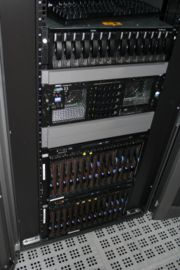Web Server
From NeoWiki
m |
|||
| Line 1: | Line 1: | ||
[[Image:Inside and Rear of Webserver.jpg|thumb|right|380px|The inside/front of a [[Dell]] [[Dell PowerEdge|PowerEdge]] web server]] | [[Image:Inside and Rear of Webserver.jpg|thumb|right|380px|The inside/front of a [[Dell]] [[Dell PowerEdge|PowerEdge]] web server]] | ||
| + | The term '''[[World Wide Web|Web]] [[Server (computing)|server]]''' can mean one of two things: | ||
| + | # A [[computer program]] that is responsible for accepting [[HTTP]] requests from clients, which are known as [[Web browser]]s, and serving them HTTP responses along with optional data contents, which usually are Web pages such as [[HTML]] documents and linked objects (images, etc.). | ||
| + | # A [[computer]] that runs a computer program which provides the functionality described in the first sense of the term. | ||
| + | <!-- empty lines to move toc down a bit --> | ||
==Common features== | ==Common features== | ||
Revision as of 05:43, 18 June 2007
The term Web server can mean one of two things:
- A computer program that is responsible for accepting HTTP requests from clients, which are known as Web browsers, and serving them HTTP responses along with optional data contents, which usually are Web pages such as HTML documents and linked objects (images, etc.).
- A computer that runs a computer program which provides the functionality described in the first sense of the term.
Contents |
Common features

Although Web server programs differ in detail, they all share some basic common features.
- HTTP: every Web server program operates by accepting HTTP requests from the network, and providing an HTTP response to the requester. The HTTP response typically consists of an HTML document, but can also be a raw text file, an image, or some other type of document (defined by MIME-types); if something bad is found in client request or while trying to serve the request, a Web server has to send an error response which may include some custom HTML or text messages to better explain the problem to end users.
- Logging: usually Web servers have also the capability of logging some detailed information, about client requests and server responses, to log files; this allows the Webmaster to collect statistics by running log analyzers on log files.
In practice many Web servers implement the following features too.
- Authentication, optional authorization request (request of user name and password) before allowing access to some or all kind of resources.
- Handling of not only static content (file content recorded in server's filesystem(s)) but of dynamic content too by supporting one or more related interfaces (SSI, CGI, SCGI, FastCGI, JSP, PHP, ASP, ASP .NET, Server API such as NSAPI, ISAPI, etc.).
- HTTPS support (by SSL or TLS) to allow secure (encrypted) connections to the server on the standard port 443 instead of usual port 80.
- Content compression (i.e. by gzip encoding) to reduce the size of the responses (to lower bandwidth usage, etc.).
- Virtual Hosting to serve many web sites using one IP address.
- Large file support to be able to serve files whose size is greater than 2 GB on 32 bit OS.
- Bandwidth throttling to limit the speed of responses in order to not saturate the network and to be able to serve more clients.
Origin of returned content
The origin of the content sent by server is called:
- static if it comes from an existing file lying on a filesystem;
- dynamic if it is dynamically generated by some other program or script or API called by the Web server.
Serving static content is usually much faster (from 2 to 100 times) than serving dynamic content, especially if the latter involves data pulled from a database.
Path translation
Web servers usually translate the path component of a Uniform Resource Locator (URL) into a local file system resource. The URL path specified by the client is relative to the Web server's root directory.
Consider the following URL as it would be requested by a client:
http://www.example.com/path/file.html
The client's Web browser will translate it into a connection to www.example.com with the following HTTP 1.1 request:
GET /path/file.html HTTP/1.1 Host: www.example.com
The Web server on www.example.com will append the given path to the path of its root directory. On Unix machines, this is commonly /var/www/htdocs. The result is the local file system resource:
/var/www/htdocs/path/file.html
The Web server will then read the file, if it exists, and send a response to the client's Web browser. The response will describe the content of the file and contain the file itself.
Performances
Web servers (programs) are supposed to serve requests quickly from more than one TCP/IP connection at a time.
Main key performance parameters (measured under a varying load of clients and requests per client), are:
- number of requests per second (depending on the type of request, etc.);
- latency time in milliseconds for each new connection or request;
- throughput in bytes per second (depending on file size, cached or not cached content, available network bandwidth, etc.).
Above three parameters vary noticeably depending on the number of active connections, so a fourth parameter is the concurrency level supported by a Web server under a specific configuration.
Last but not least, the specific server model used to implement a Web server program can bias the performance and scalability level that can be reached.
Load limits
A web server (program) has defined load limits, because it can handle only a limited number of concurrent client connections (usually between 2 and 60,000, by default between 500 and 1,000) per IP address (and IP port) and it can serve only a certain maximum number of requests per second depending on:
- its own settings;
- the HTTP request type;
- content origin (static or dynamic);
- the fact that the served content is or is not cached;
- the hardware and software limits of the OS where it is working.
When a web server is near to or over its limits, it becomes overloaded and thus unresponsive.
Overload causes
At any time Web servers can be overloaded because of:
- too much legitimate Web traffic (i.e. thousands or even millions of clients hitting the Web site in a short interval of time);
- DDoS (Distributed Denial of Service) attacks;
- Computer worms that sometimes cause abnormal traffic because of millions of infected computers (not coordinated among them);
- XSS viruses can cause high traffic because of millions of infected browsers and/or web servers;
- Internet web robots traffic not filtered / limited on large web sites with very few resources (bandwidth, etc.);
- Internet (network) slowdowns, so that client requests are served more slowly and the number of connections increases so much that server limits are reached;
- Web servers (computers) partial unavailability, this can happen because of required / urgent maintenance or upgrade, HW or SW failures, back-end (i.e. DB) failures, etc.; in these cases the remaining web servers get too much traffic and of course they become overloaded.
Overload symptoms
The symptoms of an overloaded Web server are:
- requests are served with (possibly long) delays (from 1 second to a few hundred seconds);
- 500, 502, 503, 504 HTTP errors are returned to clients (sometimes also unrelated 404 error or even 408 error may be returned);
- TCP connections are refused or reset (interrupted) before any content is sent to clients;
- in very rare cases, only partial contents are sent (but this behaviour may well be considered a bug, even if it usually depends on unavailable system resources).
Anti-overload techniques
To partially overcome above load limits and to prevent the overload scenario, most popular Web sites use common techniques like:
- managing network traffic, by using:
- Firewalls to block unwanted traffic coming from bad IP sources or having bad patterns;
- HTTP traffic managers to drop, redirect or rewrite requests having bad HTTP patterns;
- Bandwidth management and Traffic shaping, in order to smooth down peaks in network usage;
- deploying Web cache techniques;
- using different domain names to serve different (static and dynamic) content by separate Web servers, i.e.:
-
http://images.example.com
-
http://www.example.com
-
- using different domain names and / or computers to separate big files from small and medium sized files; the idea is to be able to fully cache small and medium sized files and to efficiently serve big or huge (over 10 - 1000 MB) files by using different settings;
- using many Web servers (programs) per computer, each one bound to its own network card and IP address;
- using many Web servers (computers) that are grouped together so that they act or are seen as one big Web server, see also: Load balancer;
- adding more HW resources (i.e. RAM, disks) to each computer;
- tuning OS parameters for HW capabilities and usage;
- using more efficient computer programs for Web servers, etc.;
- using other workarounds, specially if dynamic content is involved.
Historical notes
In 1989 Tim Berners-Lee proposed to his employer CERN (European Organization for Nuclear Research) a new project, which had the goal of easing the exchange of information between scientists by using a hypertext system. As a result of the implementation of this project, in 1990 Berners-Lee wrote two programs:
- a browser called WorldWideWeb;
- the world's first Web server, which ran on NeXTSTEP; NOTE: today, this machine is on exhibition at CERN's public museum, Microcosm.
The first web server in U.S.A. was installed on December 12, 1991 at SLAC [1]
Between 1991 and 1994 the simplicity and effectiveness of early technologies used to surf and exchange data through the WorldWideWeb helped a lot to:
- port them to many different OSs;
- spread their use among lots of different social groups of people, first in scientific organizations, then in universities and finally in industry.
In 1994 Tim Berners-Lee decided to constitute the World Wide Web Consortium to regulate the further development of the many technologies involved (HTTP, HTML, etc.) through a standardization process.
The following years are recent history which has seen an exponential growth (become explosive after 2000) of the number of web sites and, of course, of the number of Web Servers.
Software
The four most common HTTP serving programs are:[2]
- Apache HTTP Server from the Apache Software Foundation.
- Internet Information Services (IIS) from Microsoft.
- Sun Java System Web Server from Sun Microsystems.
- Lighttpd
There are thousands of different Web server programs available, many of which are specialized for very specific purposes, so the fact that a web server is not very popular does not necessarily mean that it has a lot of bugs or poor performance.
See Category:Web server software for a longer list of HTTP server programs.
Statistics
The most popular Web servers, used for public Web sites, are tracked by Netcraft Web Server Survey, with details given by Netcraft Web Server Reports.
According to this site, Apache has been the most popular Web server on the Internet since April of 1996. The January 2007 Netcraft Web Server Survey found that about 60% of the Web sites on the Internet were using Apache, followed by IIS with about 30% share.
Another site providing statistics is SecuritySpace ([3]), which also provides a detailed breakdown for each version of Web server: [4]
See also
- HTTP, HTTPS
- comparison of web servers
- tiny web servers
- SSI, CGI, SCGI, FastCGI, PHP, Java Servlet, JavaServer Pages, ASP, ASP .NET, Server API
- Virtual hosting
- LAMP (software bundle)
- Web browser
- Web log analysis software
- Web hosting service
- Application server
- Mac OS X Server
- HTTP compression
External links
- RFC 2616, the Request for Comments document that defines the HTTP 1.1 protocol.


